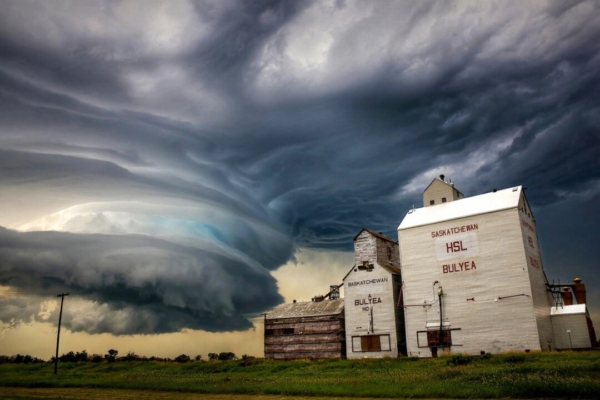Last summer, at a backyard barbecue with his family, Craig Boehm’s attention was swiftly shifting between flipping burgers on the grill and watching the radar screen. Meteorologists had warned that an impending storm might pass south of Regina, Sask., and the 47-year-old Boehm, who works in the hotel industry and pursues storm chasing as a hobby, was eager to hit the road.
As tornado warnings loomed, Boehm couldn’t wait to get going. After dinner, he quickly bid farewell to guests and, within 20 minutes, set off in a modern touring van with his wife, camera gear neatly packed.
Browsing Google Maps, he stumbled upon an abandoned old farm in Avonlea. Would this be the perfect convergence of elements? Knowing that farms make for excellent backdrops in storm photography, Boehm had a soft spot for them.
Having spent childhood summers 40 years ago on his family farm in Yorkton, southeastern Saskatchewan, where the grain elevator was the hub of activity, Boehm yearned to capture the nostalgia of old barns and structures from simpler times in the face of raging storms. He felt that using the fury of the storm as a backdrop was a “huge reward.”
Approaching Avonlea, Boehm informed his wife, “The storm is intensifying; it looks like they might issue a tornado warning.” Everything was set up for the perfect shot.
“When the storm arrived in my location, its structure was simply otherworldly,” he told The Epoch Times, adding that it turned out to be his best photo of 2024.
“What I saw was part of the updraft in the storm that looked like a cinnamon roll,” he said. “There was no rainfall in that area, so you could see this stunning storm structure. Of course, the old building was the most striking element of the picture.”
Although the storm did not produce a tornado, Boehm mentioned that it later hit southeastern Saskatchewan, bringing with it “baseball-sized hail” and causing significant damage.
Continuously scouring the country roads, old buildings in southeastern Saskatchewan have become the hallmark of Boehm’s work. Since he started storm chasing in 2012, he drives 8,000 to 13,000 kilometers each summer, marking every old grain elevator or structure he encounters on Google Maps. He can now quickly plan out potential routes to ominous stormy backdrops.
Boehm noted that these old buildings embody the essence of Saskatchewan. Many buildings disappear each year, and he has shot over twenty abandoned structures, finding satisfaction in preserving their history through photography and capturing “scenes no one can photograph again.”
A typical prairie grain elevator still standing in the Bulyea countryside in southeastern Saskatchewan is, according to Boehm, “characteristic of the province.” In July 2022, he chased a storm for 8 hours to capture this ancient tower. In the photo, it loomed tall against a backdrop of “absolutely wild storm structures.”
Boehm’s first fascination with old barns was in 2013 when he captured his favorite grain elevator in southeastern Saskatchewan before a storm. Everything lined up perfectly – the storm, the barn, Boehm himself, and even a horse – marking his debut piece.
But things don’t always go smoothly.
“Storm chasing can be very rewarding or very frustrating,” Boehm said. Shooting requires planning.
“I check the weather forecast one to three days ahead,” he said. Then he picks the days to take off.
“On chasing days, I check the latest weather models in the morning when I need to pinpoint a target,” he said. Sometimes there are multiple targets to choose from.
In the midst of storms, danger looms. Taking many precautions, Boehm highlights what the biggest risks are.
“I think the most significant danger is not the storm itself,” he said, “but the driving back and forth during chasing: other drivers, road conditions, animals all pose significant risks.”
“The worst-case scenario is running out of gas,” he added. “Once I reach a target location, I fill up the tank because in rural Saskatchewan, you never know when the next refuel opportunity will be.”
If lightning gets too close, Boehm shoots from inside the touring van.
In the summer of 2018, while accompanying a group of chasers near Wood Mountain, Boehm witnessed four tornadoes sweeping eastward. A new storm approached from the south.
“A small tornado crossed the road about 75 yards ahead of us, causing EF1 (enhanced Fujita scale) damage,” he said. “As we continued east, roadside power poles were blown over by the wind.”
As the convoy drove through “ping-pong ball-sized hail and rain,” they encountered a multi-vortex tornado that turned into a rare wedge tornado.
“If we had been a few minutes late, the situation could have been very bad because the tornado passed right where we were coming from,” Boehm mentioned.
As a storm photographer, Boehm strives to minimize risks and learn from mistakes. He always plans escape routes and refuses to chase at night.
Despite the dangers, he explained what drives him to head towards storms: “To capture that moment, to take photos that others can’t.”
He mentioned that storm chasing has also led him to forge lifelong friendships, which is one of the most underestimated parts of storm chasing.
Once the chase begins, Boehm and his colleagues hit the road separately.
“I usually try to choose a route different from other chasers, or a location that allows me to capture a unique photo,” he said. “Who wants to see ten identical photos, right?”

